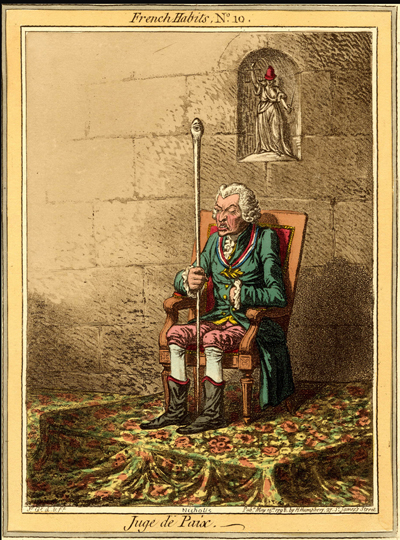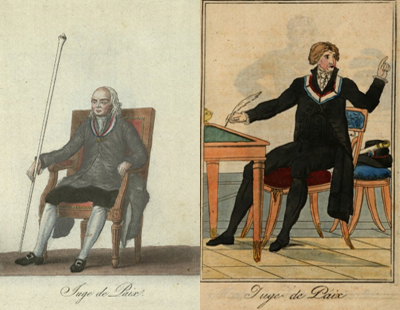French Habits: Juge de Paix
This is the tenth in a series of twelve plates in which Gillray portrays members of the Whig opposition wearing the new ceremonial robes designed by Jacques-Louis David for the prominent public officials of the French Directorate. In this plate, John Nicholls is shown as a Juge de Paix.

© Trustees of the British Museum
According to the English "translation" of the French specification, the "Justices of the Peace have no peculiar dress;"
but as a mark of distinction, they shall wear a branch of olive, made of metal, suspended by a white ribbon with a very small blue and red border. They shall have in their hand a long white stick with an ivory head, on which shall be engraved a black eye.
Gillray follows the French illustration in presenting Nicholls sitting in an arm chair with the white stick and olive branch suspended from the ribbon around his neck. But he has made a number of changes in the interest of his caricature of Nicholls. The chair is narrow; Nicholls sits rigidly upright; the white stick is grasped rather than held; the stick is absolutely upright; he wears half-boots exposing his spindly legs; his arms are held close to his body. Every detail contributes to a sense of constriction and rigidity, of someone tightly wound.
And then there is Nicholls' expression. Nicholls was blind in one eye, so he probably had a natural squint. But Gillray takes this opportunity to emphsize and call attention to that deformity, by seating him beneath a statue of "Blind Justice" and making the eye on top of his white stick particularly prominent. In Gillray's depiction, Nicholls' squint becomes an ugly look of hostility and disdain. And though Justice may be blind, she is distinctly revolutionary and French, wearing a bonnet rouge.

of the Robes Prescribed for the Juge de Paix [1796]
Sources and Reading
- Commentary from the British Museum on French Habits: Juge de Paix.
- "John Nicholls (MP)," Wikipedia
- Collection des nouveaux costumes des autorités constituées, civils et militaires
- Dresses of the Representatives of the People. . .
- Thomas Wright and R.H. Evans, Historical and Descriptive Account of the Caricatures of James Gillray #194
- Thomas Wright and Joseph Grego, The Works of James Gillray, the Caricaturist; With the History of His Life and Times pp. 239-240.
NEXT: French Habits 11
Comments & Corrections
NOTE: Comments and/or corrections are always appreciated. To make that easier, I have included a form below that you can use. I promise never to share any of the info provided without your express permission.